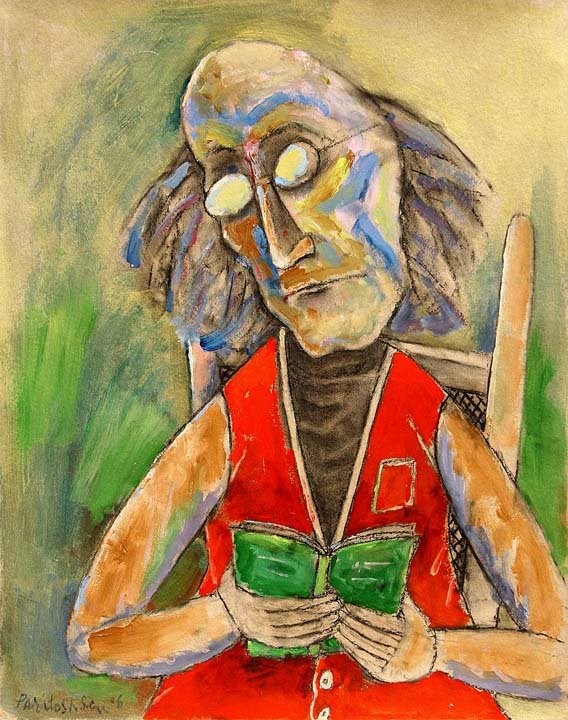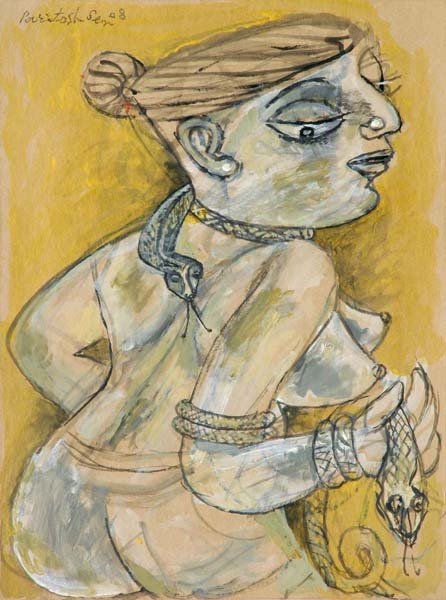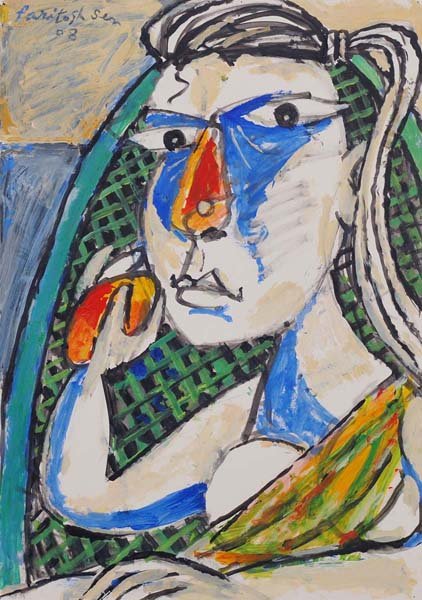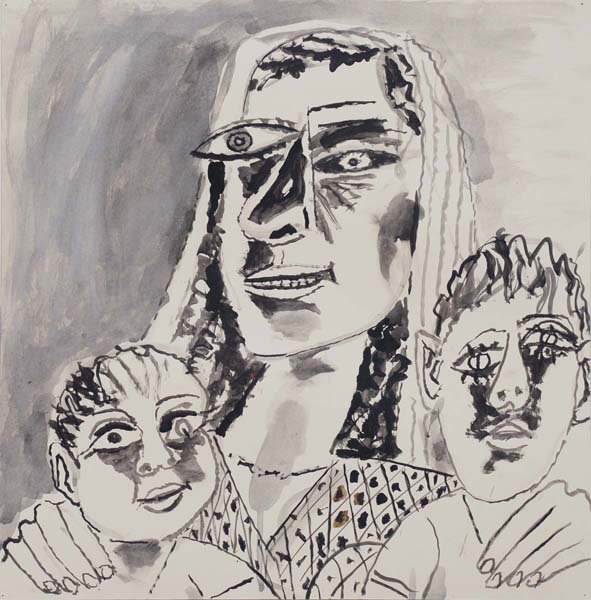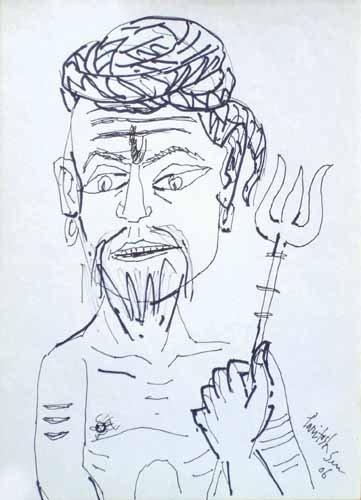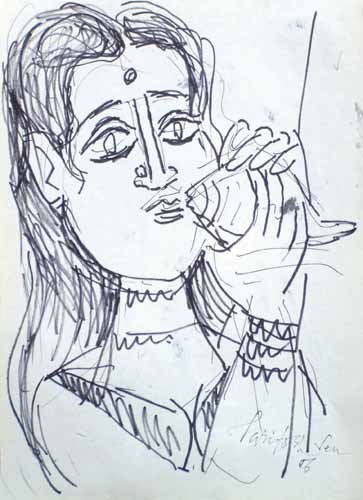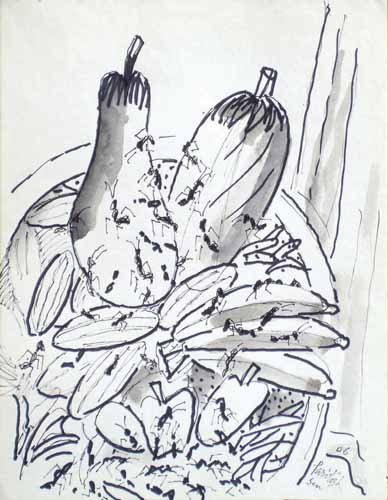
Paritosh Sen
April 23 - May 7, 2010
The value of drawing lies not only in its being the actual, physical point of take-off of the artist’s work, but also in its ability to hold on a mirror to the artist’s entire practice in the most effective manner.
The automatic elements involved in drawing, constitute its immediate nature. These elements in the form of visual indexes, markers etc begin to surface as the process of the execution of drawing proceeds. The elements become essential means, reflecting on certain nuances of the artist’s psyche and practice. These direct, almost unaffected responses, on their way towards the making of the individual’s work either become pronounced and deliberate, loud statements or get subdued and subtle through cultural masking. Thus, it is only the drawing that like a seismograph records the slightest stir in the artist’s reactions and responses and presents them in the purest possible forms. Yet this language of drawing in which an artist expresses his personal experiences, remains relative like language (symbolic order) itself. Therefore what becomes interesting in reading of drawings is the ways in which an individual bends the visual symbolic order according to one’s demands of expression.
The viewing of Paritosh Sen’s drawing particularly becomes interesting in this context. Paritosh Sen (b.1918) belonged to that generation of artists who imbibed the intrinsic values of drawings through a language amalgamating elements derived from various cultural contexts. The artist’s language of expression was formed through his training in the realist-illusionist tradition of picture-making, handed down by the colonial academic institutions, an exposure to western modernist traits through his visit to the West in his formative years, a conscious study of ethnographic artifacts like tribal sculptures in particular and an exploration of the oriental visual register for which the artist had a partial empathy. This language accommodated a wide range of the artist’s experiences, creating scopes of various readings regarding the location of Paritosh Sen in relation to his time and space. Two Drawings depicting an accident of a bicycle rider from the early 1970s in this show bear distinct marks of reactions against the upheavals of the period leading to state-organised violence. The visual language of the presentation throws light on his connection with the Calcutta Group during the early 1940s. Here a group of young artists questioned the hypotheses of the elders in search of a new language to express the situation of unrest resulting from the war and its consequences felt in the subcontinent. The artist like many others “quite rightfully looked towards the West for a new language”. Though the approach of the 1940s with a language full of gestures of defiance never lost relevance to the artist and came back to him time and again, parallel streaks of different approaches to drawings also emerged during the late 1970s. The visuals complemented his literary practices. It was during this time that he published some of his writings like Jindabahar, Aam Sundari and Other Stories and A Tree in My Village. These writings, some of which were quintessentially autobiographical in nature, presented stories that extensively explored the elements of memory. This necessitated an inward journey in terms of formulating a visual register that could do justice to his writings. These drawings appearing in the form of manuscript illuminations shared in character the elements of medieval manuscript illuminations where the artists almost set themselves a ‘mnemonic exercise’ and created visual codes by reducing forms of the depicted objects into essences. As a consequence the ‘ordinary’ got transformed into the ‘aesthetics’ thereby leading to the emergence of a rich visual vocabulary. The animated characteristics of the drawings here presenting a detailed close-up view of activities perfectly matched the extensive nature of the writings. According to the artist, the close-up view has another source in cinema, particularly the visuals created by the Danish filmmaker Carl Dreyer, in his film Joan of Arc.
Just as the cinematic presentation inspired Paritosh Sen to explore the nuances of a close-up view, a completely different genre like the Kalighat Pat with its singular bloated figures covering the entire picture format contributed to the pictorial idea of the artist. This is evident in the charcoal drawings of the figures in action. The cultivation of this genre with an intention to add a new dimension gave him an access to the exploration of the languages like mockery (a woman seated on a commode with a telephone receiver, the statesman on his throne) , violence (bicycle rider with chickens turned up-side down). These figures in the charcoal drawings have been so conceived that they appear almost like motifs/codes with critical social, political and even moralistic connotations. Moreover, this gave him an opportunity to look into the degrees of compatibilities between the elements of structural art of the modernist West and the calligraphic linear orientation of Kalighat Pat. Reconciliation between ideas, concepts, contents and even genres has been one of the significant occupations of post-independent Indian art. In this exhibition of drawings one sees, how one of the exponents of contemporary Indian art has addressed the area of stylistic reconciliation through working over a period of more than six decades.
Adip Dutta
Paritosh Sen | Woman with Cockatoo | Charcoal on paper | 60x 40 in | 2007
Paritosh Sen | Woman in the rain | Acrylic on paper board | 29.5 x 24 in | 2006
Paritosh Sen | Woman with cat | Acrylic on paper board | 60 x 40 in | 2007
Paritosh Sen | Self portrait with book | Acrylic on paper board | 29 x 33 in | 2006
Paritosh Sen | Self Portrait 1 | Acrylic on canvas | 60 x 40 in | 2008
Paritosh Sen | Suddenly there was water all around | Acrylic on paper board | 60 x 40 in | 2007
Paritosh Sen | Snake charmer woman | Acrylic on paper | 24.25 x 18 in | 2008
Paritosh Sen | Frog | Watercolor on paper | 18.5 x 22.5 in | 2008
Paritosh Sen | Owls | Acrylic on paper | 19 x 15 in | 2006
Paritosh Sen | Man crying 1 | Acrylic on paper | 39 x 29 in | 2008
Paritosh Sen | Man crying 2 | Charcoal on paper | 30 x 24 in | 2007
Paritosh Sen | Urchin | Acrylic on paper | 19.5 x 14 in | 2008
Paritosh Sen | Woman eating Mango | Acrylic on paper | 19.75 x 13.75 in | 2008
Paritosh Sen | Woman with two children | Acrylic on paper | 18.5 x 19 in
Paritosh Sen | Girl with Dog | Acrylic on paper board | 30.75 x 24.75 in | 2008
Paritosh Sen | Dancer | Acrylic on paper | 42.25 x 30.25 in | 2008
Paritosh Sen | Woman drinking tea | Acrylic on paper | 42.25 x 30.25 in | 2008
Paritosh Sen | Sarod player | Acrylic on paper | 42.25 x 30.25 in | 2008
Paritosh Sen | Woman with scissors | Acrylic on paper | 42.25 x 30.25 in | 2008
Paritosh Sen | Ektara seller | Acrylic on paper | 39.5 x 29.5 in | 2007
Paritosh Sen | Woman at the window (front) | Pen & ink on paper | 14.5 x 10.75 in | 2006
Paritosh Sen | Boy playing Flute | Pen & ink on paper | 14.5 x 10.75 in | 2006
Paritosh Sen | Sadhu with Trishul 2 | Pen & ink on paper | 14.5 x 10.75 in | 2006
Paritosh Sen | Sadhu with Trishul 1 | Pen & ink on paper | 14.5 x 10.75 in | 2006
Paritosh Sen | Woman in the balcony (back) | Mixed media on paper | 14.5 x 10.75 in | 2006
Paritosh Sen | Lady with conch 1 (front) | Mixed media on paper | 14.5 x 10.75 in | 2006
Paritosh Sen | Lady with conch 2 (Back) | Pen & ink on paper | 14.5 x 10.75 in | 2006
Paritosh Sen | Still life with ants 1 | Ink & wash on paper | 13.5 x 10.5 in | 2006
Paritosh Sen | Still life with ants 2 | Pen & Ink on paper | 14.5 x 10.75 in | 2006
Paritosh Sen | Boy eating corn | Pen & ink on paper | 14.5 x 10.75 in | 2006
Paritosh Sen (1918 - 2008)
Born in Dhaka, (now Bangladesh) in 1918 Paritosh Sen got Dip. in Fine Arts from the Government College of Arts and Crafts, Chennai in 1940. In 1942, he moved to Calcutta. In 1949, he left for Paris to study further, attending, among other institutes, the Ecole des Beaux-Arts. He received a Fellowship for 1970-'71 from the John D. Rockefeller III Fund.
A painter, illustrator, tutor and writer, Paritosh Sen has been a part of the world of Indian art, for close to four decades now. Sen's more recognizable works are his caricatures, which reflect strong underlying socio-political shades, and his female nude drawings. His style of representation is influenced by his exposure to Western Modern art and has traces of cubism. He uses two dimensional, structured planes but still creates an illusion of voluptuousness. His drawings and paintings are noted for their strong lines and bold, stylized strokes. Although the colour is an important aspect of his paintings, it is the human figure, expressing a myriad of emotions that dominates his art. A recurrent subject in Sen's works is his depiction of scenes from everyday urban life. These activities are rendered from a cynical and detached perspective, which is typically Sen's viewpoint.
Paritosh Sen passed away in October 2008.




